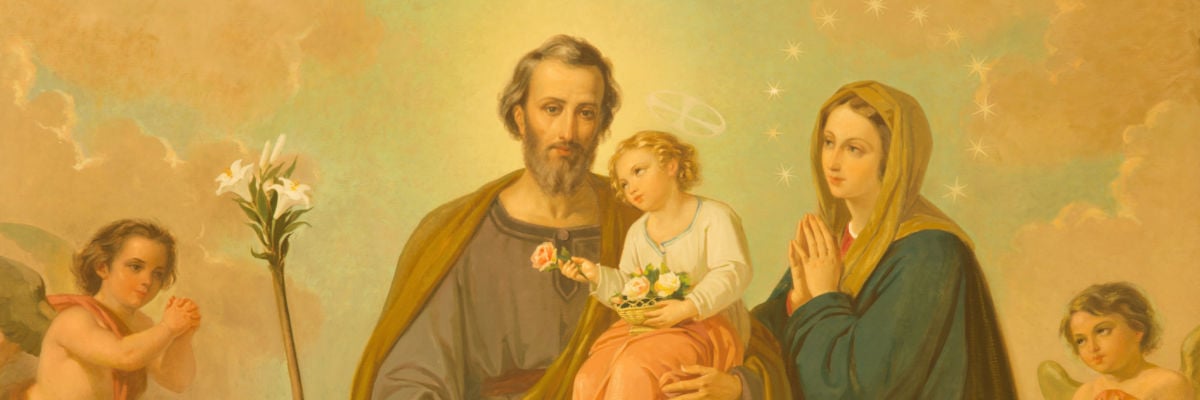
Was St. Joseph an old man or a young man when Jesus was born?
Scripture does not tell us explicitly, and there’s no consensus within Catholic art or theology on the matter. Our own assumptions about Joseph’s age might depend on which art we’ve happened to see. For instance, Caravaggio’s Rest on the Flight into Egypt depicts Joseph as an old man, with gray hair and a gray beard, alongside a young Mary, nursing the Christ Child. But El Greco’s St. Joseph and the Christ Child, painted only a few years later, depicts Joseph as a much younger man. Why the discrepancy?
These days, the “old Joseph” camp is largely associated with the Eastern half of the Church and with Eastern Orthodoxy. Why might a person believe that St. Joseph was an older man? Usually, the people holding to this view believe that Joseph was a widower, and that the “brothers” of Jesus mentioned in the Bible were Joseph’s children from a previous marriage. St. Epiphanius, for instance, argued that St. James “was Joseph’s son by Joseph’s first wife, not by Mary.” Additionally, those who hold the “old Joseph” view point out that Joseph appears to have died some time between Jesus’ thirteenth year and his public ministry: the last we hear of him is after the finding of Jesus in the Temple (Luke 2:41:51).
A major reason for this view’s popularity in the East is the influence of a popular second-century text called the Protoevangelium of James, falsely claimed to be written by the Apostle James. In the Protoevangelium’s account, after the Virgin Mary turned twelve, heralds went out to all of Judaea to find widowers who could marry her to protect her and preserve her pledged virginity. The widowers, each carrying rods, came before the high priest, and a dove flew out of Joseph’s rod, signifying God’s choice. Joseph initially refused, saying, “I have children, and I am an old man, and she is a young girl. I am afraid lest I become a laughing-stock to the sons of Israel.” Joseph remains ashamed of this age difference and considers claiming Mary as his daughter (rather than his wife) in responding to the census. Even after the birth of Jesus, he insists that while they are betrothed, Mary is not really his wife, since her child is of the Holy Spirit.
A later (perhaps sixth-century) Egyptian text called The History of Joseph the Carpenter went farther, claiming that Joseph lived to be 111 and presenting Jesus as saying Joseph “lived forty years unmarried; thereafter his wife remained under his care forty-nine years, and then died. And a year after her death, my mother, the blessed Mary, was entrusted to him by the priests, that he should keep her until the time of her marriage.” By that telling, Joseph was already in his nineties by the time Jesus was born.
The Protoevangelium is from the East (perhaps Syria), and its stories became popular in both East and West, but Western theologians tended not to take its accounts seriously. The book was among those condemned by Pope Innocent I in 405, and again by the “Decretum Gelasianum.” Nevertheless, stories from the Protoevangelium crept into the Western medieval imagination via yet another false Gospel, a seventh-century text called The Gospel of Pseudo-Matthew, which implausibly claimed both to have been written in Hebrew by the apostle and translated into Latin by St. Jerome. This text borrows heavily from the Protoevangelium and presents Joseph as saying Mary is younger than his grandchildren.
Even while theologians (including the pope) criticized the texts as unreliable, their stories nevertheless captured the public’s imagination, an influence that can be seen on centuries’ worth of art (primarily paintings, but also medieval dramas and even songs, like “The Cherry-Tree Carol”) throughout the Church.
What caused Western theologians to reject this view of St. Joseph in favor of a younger Joseph? Partially, the influence of St. Jerome, who argued that the “brothers” of Jesus were more likely first cousins (Aramaic uses “brothers” as a kind of familial catch-all). Two of the “brothers” St. Mark mentions, James and Joses (6:3), he later describes as the sons of another Mary (15:40,47)—likely, Mary, the wife of Clopas (John 19:25; Luke 24:18). Thus, they do seem to be not Joseph’s sons from a previous marriage, but the sons of Mary and Clopas (who tradition holds was Joseph’s brother).
Jerome’s view eliminates the need to believe that Joseph was a widower, but it doesn’t automatically mean that Joseph was a young man. For that, we should look to the influence of theologians like Jean Gerson (1363-1429), chancellor of the prestigious University of Paris, who used sermons, theological treatises, and even poetry to argue that St. Joseph was being overlooked and misunderstood. Was it really likely that the man who fled with his family into Egypt in the middle of the night was a nonagenarian? And if he did have kids from a previous marriage, where were they during the events of the first Christmas?
More important was the implicit view of chastity. As Ven. Fulton Sheen would later observe, many of the popular “old Joseph” depictions “unconsciously made Joseph a spouse chaste and pure by age rather than virtue.” Sheen argued that Joseph “was probably a young man, strong, virile, athletic, handsome, chaste, and disciplined,” the kind of man one sees sometimes “working at a carpenter’s bench. Instead of being a man incapable of love, he must have been on fire with love.” St. Josemaría Escrivá, founder of Opus Dei, agreed: “I see him as a strong young man, perhaps a few years older than our Lady, but in the prime of his life and work.” Whatever his age, Joseph was of working age recently enough for the townspeople to describe the adult Jesus as “the carpenter’s son” (Matt. 13:55), and as Pope Francis points out, it was from St. Joseph that Jesus learned “the value, the dignity and the joy of what it means to eat bread that is the fruit of one’s own labor.”
A via media is possible. Recent historical scholarship, looking at rabbinical sources (telling people how they should conduct marriage) and the handful of ancient Jewish marriage documents (showing how they actually did) has given us greater insight into the marrying age of first-century Jews. Michael L. Satlow, professor of religious studies and Judaic studies at Brown University, summarizes by saying Jewish men in first-century Palestine may have married around thirty, with Jewish women marrying in their mid- to late-teens. The evidence is far from conclusive, and there’s nothing preventing Joseph from marrying earlier or later than average (particularly if he was remarrying), but it paints a different portrait of Joseph from a man either 90 years old or only a few years older than Mary. Such a man would likely have been strong enough to work as a carpenter and transport his family from Nazareth to Bethlehem to Egypt, but he would also be more likely to predecease his young wife, and it would be hardly surprising for him not to live to see his son’s adult ministry.
As you can see, great theologians and even great saints are divided on the question of the age difference between Joseph and Mary. But where we are all united is in our being under Joseph’s fatherly protection, and our need for his intercession. St. Joseph, pray for us!



